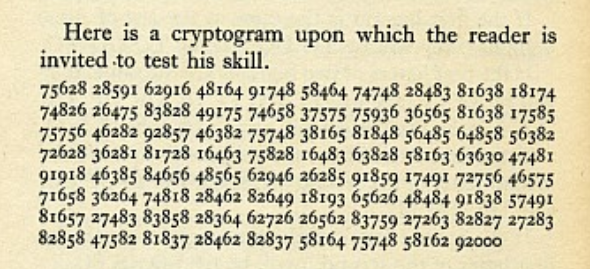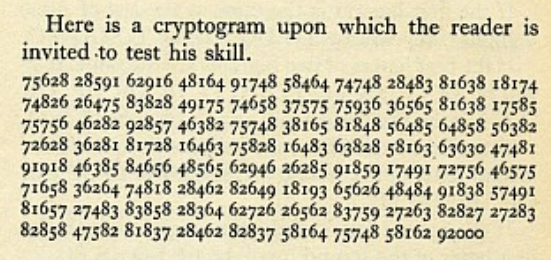A crypto book published in 1939 contains an excercise cryptogram. Many have tried to solve it, but the solution is still unknown.
I can hardly believe it. I have been a crypto history blogger for over four years now with about 750 posts published, but so far I have not blogged about a quite well-known unsolved crypto mystery: the D’Agapeyeff cryptogram.
The D’Agayeff cryptogram is mentioned in many “top ten unsolved ciphers” list, for instance the following one presented in a video on YouTube. MysteryTwister C3, a web portal dedicated to codebreaking puzzles, has a D’Agapeyeff challenge in the X section (X stands for unsolved). Here’s the English version, here’s the German one. I am the author of this challenge, by the way.
Seven years after I wrote this MTC3 challenge, it is now high time to cover the D’Agapeyeff cryptogram on Klausis Krypto Kolumne.
The challenge
In 1939 the Russian-born Briton Alexander D’Agapeyeff published a book named Codes and Ciphers.
When looking for information about a vintage crypto book it is always a good idea to check Tobias Schrödels crypto bibliography, which lists no less than 538 books. In fact, D’Agapeyeff’s Codes and Ciphers can be found there. According to Tobias, Codes and Ciphers is not one of the top books about the subject, but it’s an entertaining read and it renders a good summary of the most important encryption methods of the time.
D’Agapeyeff’s Codes and Ciphers is best remembered for a ciphertext printed on the last page. It was meant as an excercise. Here it is:
It soon became clear that this challenge was not an easy one. In fact, nobody at all could decipher this message. Meanwhile many professional and hobby codebreakers have tried to solve it, but to no avail.
Basic analysis
Here’s a transcription of the challenge:
75628 28591 62916 48164 91748 58464 74748 28483 81638 18174
74826 26475 83828 49175 74658 37575 75936 36565 81638 17585
75756 46282 92857 46382 75748 38165 81848 56485 64858 56382
72628 36281 81728 16463 75828 16483 63828 58163 63630 47481
91918 46385 84656 48565 62946 26285 91859 17491 72756 46575
71658 36264 74818 28462 82649 18193 65626 48484 91838 57491
81657 27483 83858 28364 62726 26562 83759 27263 82827 27283
82858 47582 81837 28462 82837 58164 75748 58162 92000
As adjacent columns are formed alternately from 67890 and 12345 characters respectively, it makes sense to write the message as a sequence of pairs:
75 62 82 85 91 62 91 64 81 64 91 74 85 84 64 74 74 82 84 83 81 63 81 81 74
74 82 62 64 75 83 82 84 91 75 74 65 83 75 75 75 93 63 65 65 81 63 81 75 85
75 75 64 62 82 92 85 74 63 82 75 74 83 81 65 81 84 85 64 85 64 85 85 63 82
72 62 83 62 81 81 72 81 64 63 75 82 81 64 83 63 82 85 81 63 63 63 04 74 81
91 91 84 63 85 84 65 64 85 65 62 94 62 62 85 91 85 91 74 91 72 75 64 65 75
71 65 83 62 64 74 81 82 84 62 82 64 91 81 93 65 62 64 84 84 91 83 85 74 91
81 65 72 74 83 83 85 82 83 64 62 72 62 65 62 83 75 92 72 63 82 82 72 72 83
82 85 84 75 82 81 83 72 84 62 82 83 75 81 64 75 74 85 81 62 92 00 0





Kommentare (8)